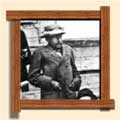 Heritage Community Foundation Presents
Heritage Community Foundation PresentsAlberta Online Encyclopedia
 |
||
  |
||
|
Home>> The Industry>> Coal Mining>> Surveying>> Featured Article: Dr. George Mercer Dawson |
||
| Dr. George Mercer Dawson | ||
|
George Mercer Dawson was one of the most remarkable Canadian scientists of the 19th century. The son of Sir John William Dawson (commonly called Principal Dawson when he became principal of McGill University in 1855), young Dawson was born in Pictou, Nova Scotia, on I August 1849 and died in Ottawa on 2 March 1901. He was educated by tutors, attended McGill University for a time, then went to England to study at the Royal School of Mines. He graduated with nearly every honour that the School of Mines could bestow.
The most remarkable thing about Dawson was his physical appearance. He was much deformed, a slightly-built hunchback who grew no taller than 190 cm and had such weak lungs that his life was threatened by every cold. Yet he remained a Field geologist and explorer until 1895, establishing an almost legendary reputation as a swift, untiring traveller and intrepid climber. He studied the geology and natural history of southern Alberta from 1881 to 1883, when the Canadian Pacific Railway company decided to build, and then built, its line across the southern plains. His main interest was in the coal deposits of the region.
He was very versatile with wide-ranging interests. He wrote
scholarly articles on geology, anthropology, botany, zoology,
and history, and compiled several handbooks on Canada. He was an
excellent public speaker, teacher and popularizer; an
above-average sketcher and water-colorist; and the best of
several poets in the Survey's history. And finally he was a
diplomat, who served Canada well on various missions. This
article is extracted from Alex Johnston, Keith G. Gladwyn and L.
Gregory Ellis. Lethbridge: Its Coal Industry (Lethbridge,
Lethbridge: City of Lethbridge, 1989), Occasional Paper No. 20,
The Lethbridge Historical Society. The Heritage
Community Foundation and the Year of the Coal Miner Consortium
(of which the City of Lethbridge is the lead partner) would like
to thank the authors for permission to reprint this material. |
||
 |
||
For more on coal mining in Western Canada, visit Peel’s Prairie Provinces.


